Clock Dials and Numerals
Clockworks offers a variety of shapes and colors of clock dials and numerals. Of course the dials come in round, square, moon top and more. Many of the round dials have a choice of white, ivory or gold.
Create a new dial out of any type of material and then use the numerals to finalize the look. Most of the numerals are plastic, however we do offer two different sizes of gold aluminum numerals.
These are generally for Grandmother and Grandfather clocks. The aluminum numbers need to have epoxy to hold them in place. They do not have sticky backs like the plastic numerals. Here are some tips to order the correct clock dial and numerals.
Arabic or Roman Numerals
Clock dials and numerals come in either Roman or Arabic. Roman numerals on dials are the kind that have letters to represent the numbers.
For example, the 12 would be XII and five is written as V and so forth. The number 4 was IV in roman numerals, however the new style is IIII.
This new style is popular with clock inserts. However, it is also becoming the norm on all dials. Arabic clock numerals are just the regular numbers where 12 is written as 12. Arabic is all numbers and no letters on the clock dial.
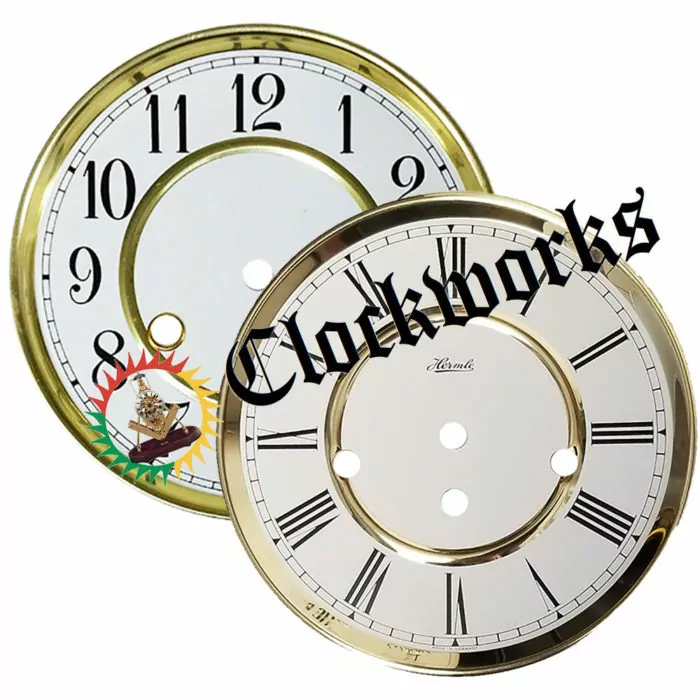
Sizing and Time Tracks
Dials come in many sizes in an attempt to cover many case styles. The sizes in the list are the overall diameter from side to side for each.
Often there is another measurement known as the time track. A time track is the small ring that travels around the just outside of the clock numerals.
In other words, the time track is the measurement of the dial from outside the 3 to outside the 9. Clock hands are usually half of the dial diameter. So clock dials and numerals will come in variable sizes to accommodate various case styles.
Clock Dials and Numerals - Types of clocks
Use these clock numerals on any type of clock dials providing the size is correct and it looks appropriate. We recommend using extra epoxy on the sticky numerals because they tend to fall off easily.
The hardest clocks to find a dial for are the antique mantle clocks. These take a bezel and glass combination that often installs on the dial itself. Use best judgement on what clock dials and numerals look best.
Clock dial drilling description
The following is a description of drilling a clock dial. Clock dials often only have the center hole for the clock hand post to come through.
If using a spring driven mechanical clock movement, need to drill holes in the dial. This is so the clock key will have access through the dial to wind the clock.
This hole is typically 3/8 of an inch wide. Drill the holes 3/8 wide in the exact spot where the winding arbor of the movement will be. Only one chance to get it right per dial so make sure to line it up perfectly.
Mark the spot to drill
This can be done by putting the dial over the clock movement while the movement is on its back. Place the dial over the movement so the hand shaft is in the center of the hole.
At this point there are two options to mark the exact spot to drill. The first method is to squeeze a marker between the movement and the dial back.
Mark the back of the dial where the winding arbor will be and therefore the spot to drill. Second, which is the easier and more exact way, is if the dial is thin enough push down with your hands so dimples show up in the dial. The downward pressure on the dial forces the winding arbors to make dimples in the thin metal indicating the exact place to drill.
Dial key hole grommets
A dial grommet is a decorative ring that sits inside the winding hole to make it look pretty. Of course, it is a metal ring with prongs on the back to fold behind the clock dial.
Thus, mounting the grommet is by friction fit. Dial grommets have a 3/8 hole in the center. In some rare situations it is 1/2 inch, however these are for very large tall case clock applications only.
Clock Dial Drilling Service
Hire Clockworks to drill the dial before it ships out. Naturally, Clockworks can drill this before shipping for a fee. So if this is of interest, please email us. We would need the movement numbers off of the back plate of the movement itself.
This information would not be in the paperwork that came with the clock or any marking on the wood clock case. It must come from the brass clockworks itself. Once we have the movement number, we can drill the winding arbor holes before the dial ships.
Clock Bezels Description
A clock bezel description consists of the brass part that holds the clock glass in place. It can be confusing to get the bezel and then the flat or convex glass.
To buy the clock bezel and then try to get the correct glass separately to put them all together is not easy. It is best to get the clock bezel glass and dial all together whenever possible.
To get the correct clock bezel, measure the diameter of the hole in the clock where it will sit. These can come with or without a hinge. The ones with the hinge are getting increasingly difficult to supply.
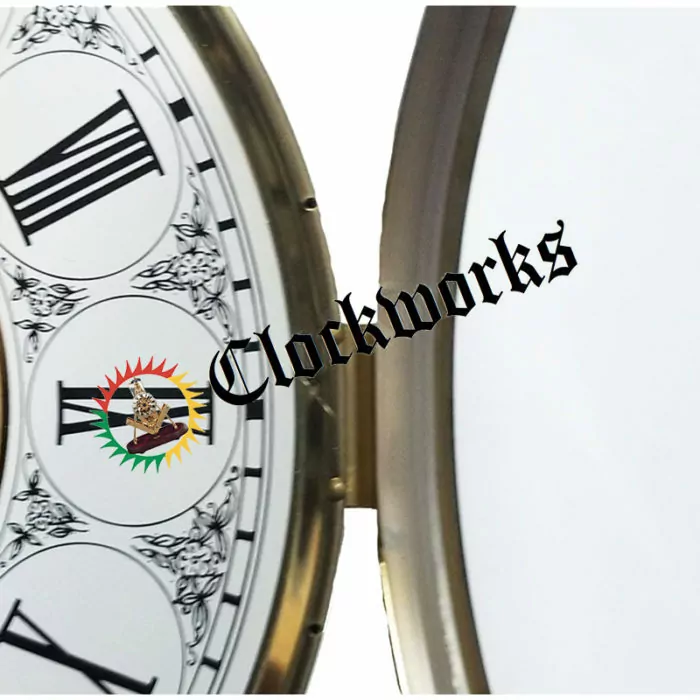
However, there are only a certain number of available sizes for these complete clock bezel units. So even though it is never a recommendation to piece meal the parts, sometimes it is a necessity.
Occasionally individual components need to be bought and then match them all together.
This can get tricky, so call and speak to us directly. That way we can marry the two items together for the perfect clock bezel and glass combination. However, it is also entirely possible that the combination cannot happen. This is especially true with larger clock bezels.
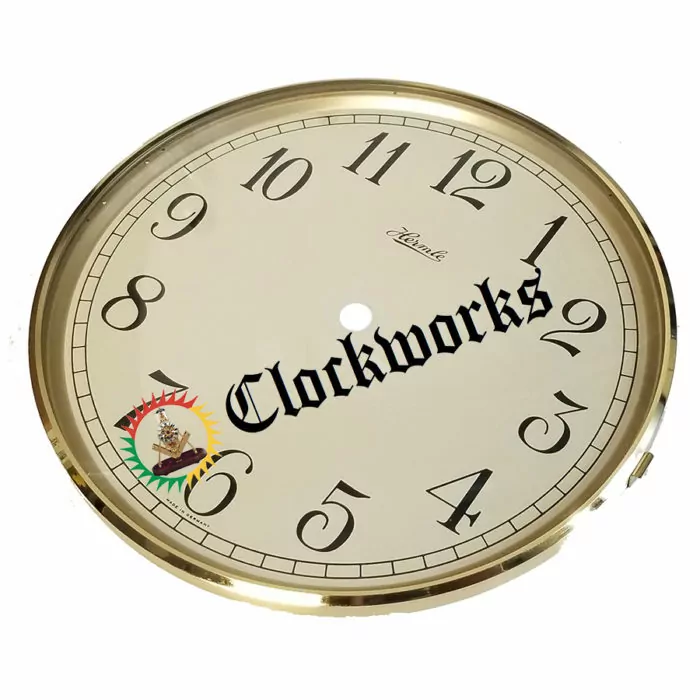
Fitting glass to the bezel
The glass has to fit into the clock bezel and it has to be a perfect fit. It cannot be too small so as to fall out of the clock bezel and not so big it will not fit into the bezel clips. For the proper size glass, measure exactly how wide the glass would need to be from the back of the bezel.
In other words, turn the bezel over and measure across the inside lip of the clock bezel where the glass sits. Remember, the glass tabs have to secure it in place. Get one that will not be too big for the bezel clips and not so small it falls out the front. Again, if there is any question, please feel free to email us or call.
Clock Dial Description of Styles
When creating clocks it is a good idea to know all the options for the dial before deciding what clock to build.
The dial is both the most important thing and also the most tricky at times when building a clock.
It is most important because that is what people look at all day long. The dial makes or breaks the clock appearance. It is tricky because often what a customer wants for a project is no longer available. However the reverse is what needs to happen.
Choices are from what is currently available and not so much what a customer really wants.This availability depends on the clock. For example, a floor clock has more dial options than a school house clock. The list below are the general types of dials available.
Paper Clock dial Description
The paper dials come square but have a round time track.
It can be left as a square or it can be cut into a circle for a round dial application.
Use spray glue to stick the paper stock dial onto a thin board or metal backing. These are quite versatile for a variety of clock types.
Because they come in so many sizes and also available in ivory or white, paper dials are a popular choice. If you need an exact size or an off size that is unavailable, these are a great solution.
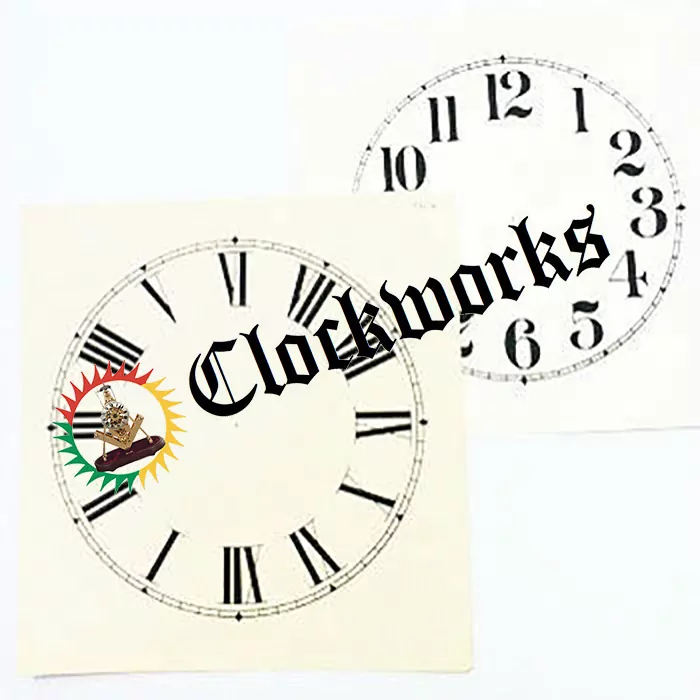
Round clock dial Description
The round metal dials may come with a protective plastic coating.
Sometimes it is hard to tell it is there so if the dial seems to have scratches, it most likely has this coating. This needs to be taken off for the final clock project.
Made of thin metal, it is possible to drill these out with holes for a clock key if working with a spring driven clock. Use dial key hole grommets to make the holes pretty after the drilling is done.
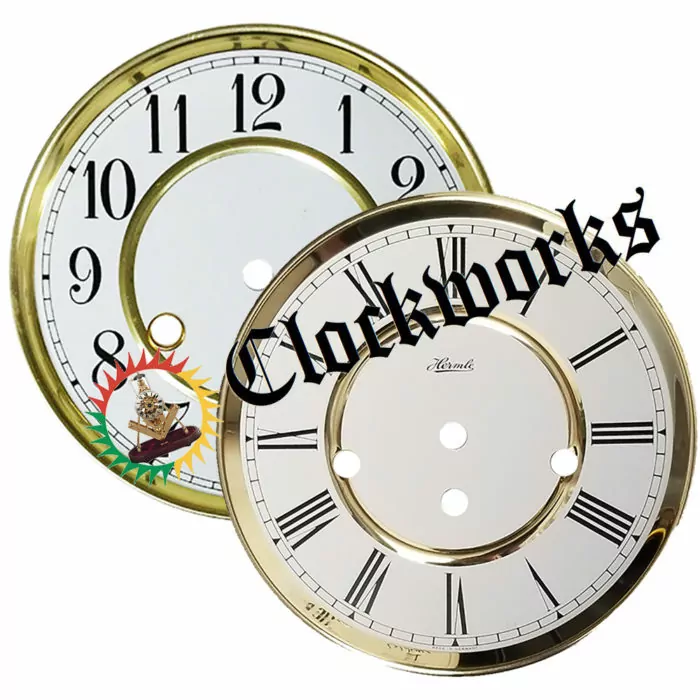
Square clock dials
You can drill Square dials for the winding of a spring driven clock.
Drill 3/8 holes where the key will go through the dial to wind the clock. Key hole grommets make the holes look good when done.
Usually the metal dials are made from thin metal, and the size and color elections are few. If the size is not available in metal, please consider paper dials instead. These come in many sizes, and are available in white or ivory color, and Roman or Arabic numerals.
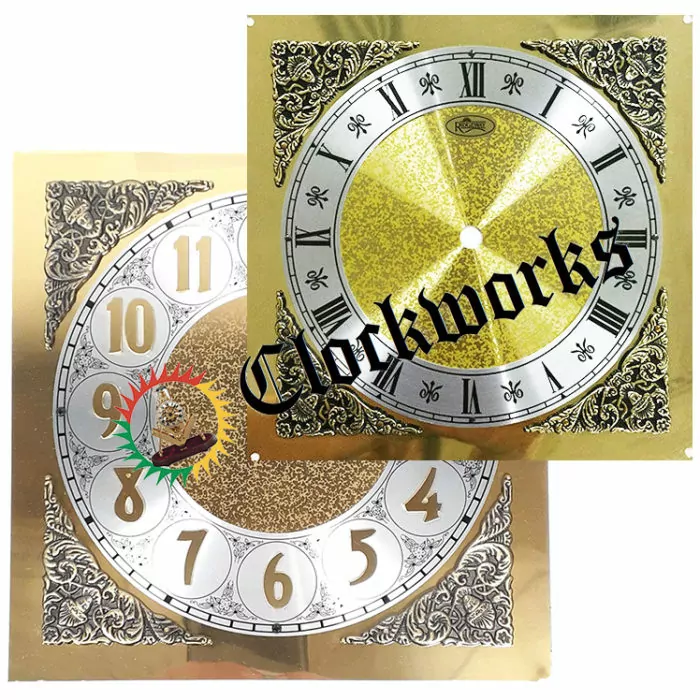
Dial with Bezels
A dial and bezel combination is the hardest one to come up with by far. The usual intent is creating an antique mantle clock.
This is usually quite frustrating due to lack of availability. To find a dial / glass / bezel / dial pan combination in the right size, with a hinge, in a specific design is not easy.
In fact, it is probably impossible. The best thing to do is to choose any other clock style to make. Best to stay clear of mantle clocks that would require this dial style.

Phase of the Moon
The clock moon dials are for floor clocks usually. The standard size is 11 x 15 1/2 inches.
So the base of the dial is 11" square and then add a 4 1/2 inch hump on the top for the lunar disk. There are a few other sizes, however this size is the industry standard for the most part.
This is a good thing because if your building a clock from kit plans, the odds are very good this dial is the size that they recommend using. For example, the likelihood of obtaining a dial that will be perfect for the project is much higher than trying to build a mantle clock.
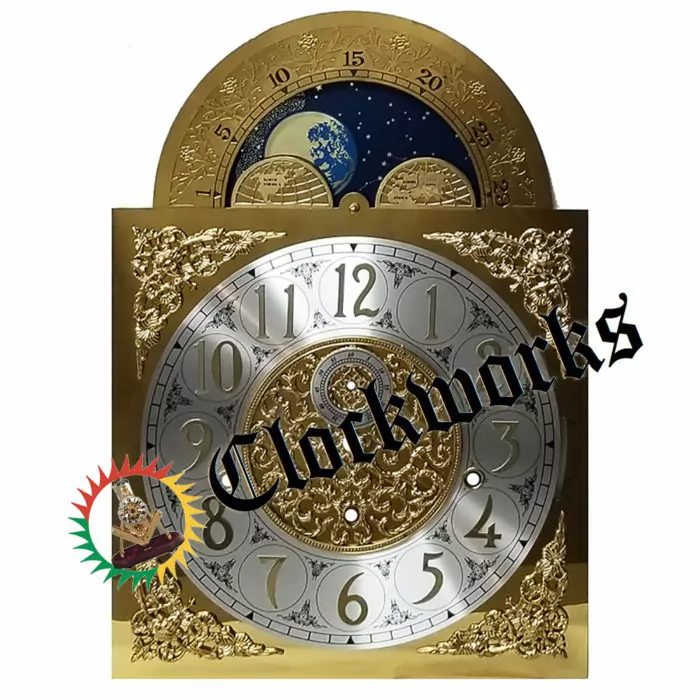
Clock Crystals - Glass Variations
Let us explore the variety of clock crystals, because the glass does have many variations. The size options are vast, however the shape requirement may not be available in the size that you need.
The first step is to identify if the glass is square, round, oblong or some other odd shape. If the glass is round, need to determine if it is convex or flat. The following paragraphs will clarify each type.
Round Convex Clock Glass Variations
Clockworks offers a large number of sizes in round convex glass. Convex means that the glass has a slight bubble to it. The glass will not be perfectly flat.
Sometimes people may say it is concave as well. This type of glass that has a bubble is found on many mantle clocks as well as many other clocks. Clockworks stocks almost every size. In addition, most small sizes are available in 1/16 increments.
Please see the product page to see the sizes available and to order the glass. Ordering is simple once you know the size that you need. Just select the size from the order button menu. Measure the round convex clock glass from one side to the other.
It is the overall diameter of the glass. Do not try to measure the side that has the bubble. Trying to do so will result in the wrong size of glass. Turn it over and measure across the flat side.
When working with a clock bezel it is important to order the right size of clock glass. If the glass is too narrow, it will fall out the front.
When a clock glass is too wide, the tabs on the back of the bezel will not be able to fold over to hold it. It needs to be between the extremes. A good fit where the bezel tabs can hold it in place.
Round Flat Clock Glass Variations
Clockworks offers flat round clock glass in many sizes. If the glass needs to be any other size than what we offer, there is a solution. Because it is only flat glass, any local glass shop can cut a circle to whatever size you need.
It will not cost much, and as long as the measurement is correct it will be perfect every time. Sometimes just taking the bezel in is enough for a glass shop to cut it.
Square Clock Case Glass
Again, go to the glass shop for this one. Some glass shops will install the glass on the wooden clock case doors if it is left with them. This is the best way.
The glass will not be found by any clock part supplier. Bringing it to the glass shop will not cost much. Also there are more options available if changing the look or type of glass.
Clock crystal oddities
During the 1950's through the 1970's there were some unusual clocks made that had odd shapes for the glass. If the clock glass needs to be convex or any other shape besides round, there is not much hope.
Unfortunately no clock supplier will have this. Another solution is to find a similar clock and use the glass from it. Again, if flat glass can be made to work, a local glass shop is the way to go.

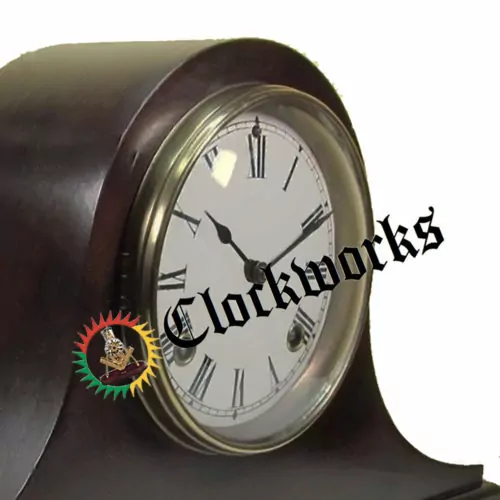
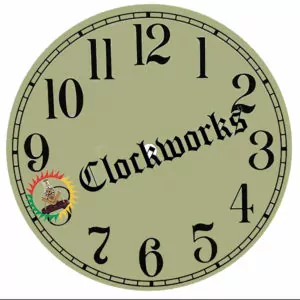
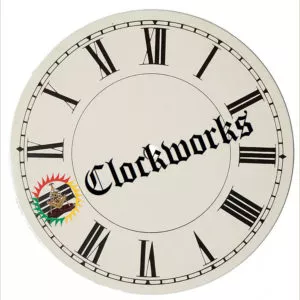
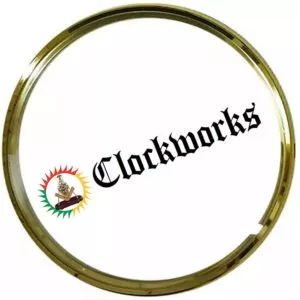
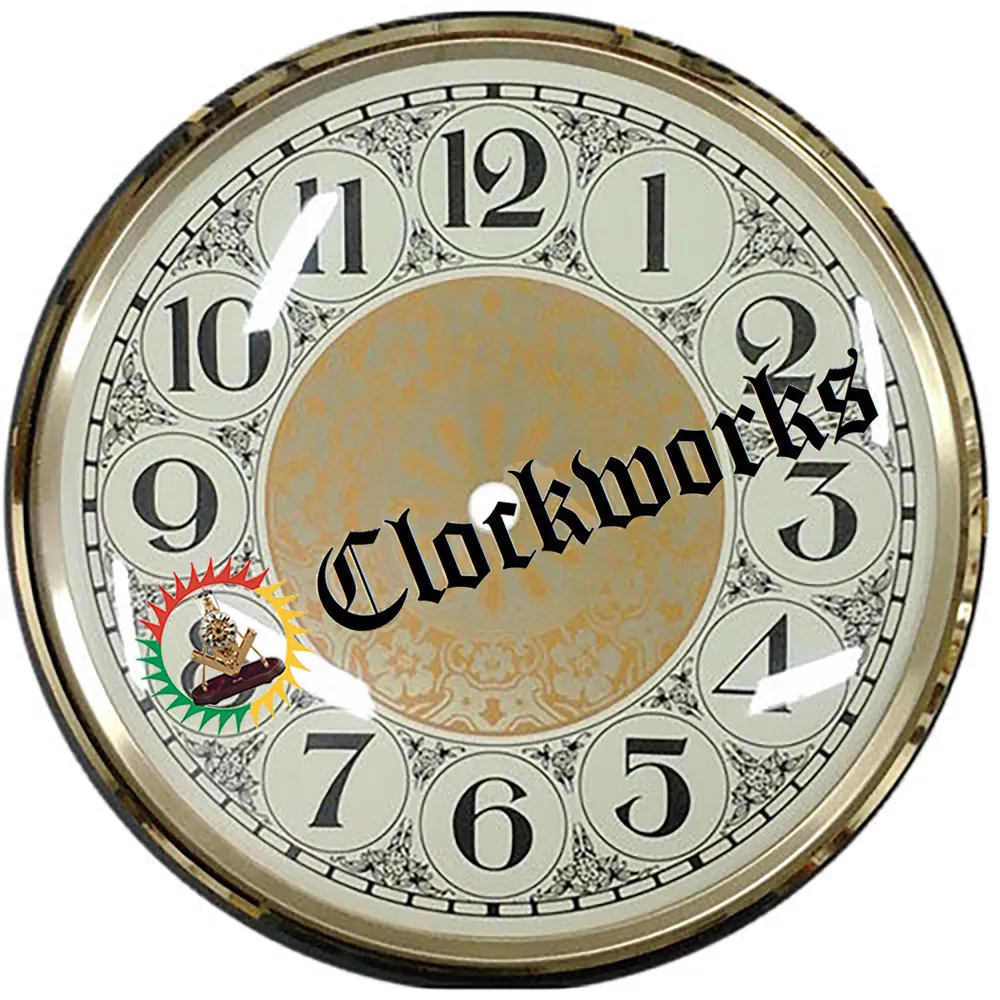











need 6 in replacement clock face 4holes with class cover for.mental clock
What are the numbers off of the back plate of the clock movement itself? If it is hard to get to, usually you can stick a cell phone up behind the movement and get a picture of the numbers. Or through the side access panel if there is one.
James Stoudenmire
40yr Clockmaker
Author of Clockworks.com
Do you sell the spring steel the pendulum hangs on?
This link
https://www.clockworks.com/product/clock-pendulum-suspension-spring-rods
James Stoudenmire
40yr Clockmaker
Author of Clockworks.com
I have a Howard Miller Regulator School House wall clock. I need the bezel and glass. I believe the glass diameter is 11.25 inches. Are these available?
Do not have this at this time. Please check back in 3 months
James Stoudenmire
40yr Clockmaker
Author of Clockworks.com
What size glass cover do I need for clock that is 14 1/2 inch’s wide round
Not sure from here
James Stoudenmire
40yr Clockmaker
Author of Clockworks.com
need a glass face Howard miller 630-187 do have 1
Square or round ?
James Stoudenmire
30yr Clockmaker
Author of Clockworks.com
I have 2 sessions from the 30’s that need glass. I believe they are 5 to 5 1/4 and 5 1/2 to 5 5/8 diameter. Do you carry these sizes?
Yes please see the drop down list of sizes, we have all mentioned
James Stoudenmire
30yr Clockmaker
Author of Clockworks.com
Looking for a convex glass 5 3/8″ (5.38) dia. for an Seth-Thomas circa 1930’s
Are they chamfered edges?
No not really beveled, but todays glass is thinner than the old days, so it usually fits the bezel ok
James Stoudenmire
30yr Clockmaker
Author of Clockworks.com
Convex
I need a 8.25” concedes diameter
We have only in stock what is listed in the drop down menu
James Stoudenmire
30yr Clockmaker
Author of Clockworks.com
Do you anticipate in the future resupplying some of the missing sizes, specifically 6.25 inch diameter?
We got a shipment in, hopefully go through and do a stock count and update the site within a day or two
James Stoudenmire
30yr Clockmaker
Author of Clockworks.com
Do the edges of the round convex clock glass have a flat edge?
Please clarify the question
James Stoudenmire
30yr Clockmaker
Author of Clockworks.com
Need convex glass 5 1/2 inches diameter
This is the best page to be on for convex glass.
James Stoudenmire
30yr Clockmaker
Author of Clockworks.com
I’m looking forward glass (51/4”) for a Seth Thomas (89AL) mantle clock
This is indeed the right place for that if your looking for convex. If the flat glass style see this link
https://www.clockworks.com/product/flat-round-clock-glass
James Stoudenmire
30yr Clockmaker
Author of Clockworks.com
I have a Howard Miller Olympia barometer 612-721 and need the round convex glass cover for the barometer meter. It’s 10 1/8″ in diameter and has a hole in the center. Thx.
Sorry do not have it with a hole
James Stoudenmire
30yr Clockmaker
Author of Clockworks.com
I have an old 7″ picture frame, could I use the convex glass in it?
From here, not sure
James Stoudenmire
30yr Clockmaker
Author of Clockworks.com
Looking for a 5-3/4 in face glass for Seth Thomas Mantle clock
Usually that would take the flat glass. This link
https://www.clockworks.com/product/flat-round-clock-glass
James Stoudenmire
30yr Clockmaker
Author of Clockworks.com
I’m looking for a convex glass cover measuring 11-3/4″ – 11–7/8″. I’ll settle for flat glass if necessary. Know any sources?
Do not have this one, best to try a local glass shop and have them custom cut it
James Stoudenmire
30yr Clockmaker
Author of Clockworks.com
I have a marine clock by Salem Clock Company Model Ranger made in Germany. I need two parts. A 4 inch bezel. Need the center wind spindel for bell side. the spindel I have the spring slips off in the middle when winding as the tang on the spindel is worn off.
Sorry do not have these parts
James Stoudenmire
30yr Clockmaker
Author of Clockworks.com
I’m looking for a 6 1/4 “high convex” round glass. Would you have one?
Sorry do not
James Stoudenmire
30yr Clockmaker
Author of Clockworks.com
convex round 5″. Do you have one? If so, how much is it
Yes, see drop down list and select 5 inch
James Stoudenmire
30yr Clockmaker
Author of Clockworks.com
Seth Thomas #2 12 and 3/8 round flat
Do not have it. Best to goto a local glass shop for this, they will cut it right then special
James Stoudenmire
30yr Clockmaker
Author of Clockworks.com
I have a 1928 Elgin 471 mantel clock that needs a new glass crystal. I measure the size to be 2.375 inches in diameter. Do you have something that will work for this clock? Thanks
Sorry do not have this that small, its more like a pocket watch crystal your after instead of a clock part.
James Stoudenmire
30yr Clockmaker
Author of Clockworks.com
How much for 7 od inch bezel & glass
Bezel and glass offerings
https://www.clockworks.com/?post_type=product&s=Bezel
James Stoudenmire
30yr Clockmaker
Author of Clockworks.com
I am looking for a replacement glass for a clock I have in my classroom. I measured across the back of the clock from one side to the other through the middle and it was 12″. Can I purchase one of these at your business? I am leaving my email and you also may call me.
Thanks,
Mark Roberts
[email protected]
614-352-0765
Sorry do not have that size
James Stoudenmire
30yr Clockmaker
Author of Clockworks.com
Thanks for helping me find this clockworks.
Hi I would like to purchase a 5 3/8 piece of Round Convex Clock Glass. What is the actual thickness of the glass? My bezel looks very slightly under 1/8″. Thank you. Gene
Between 1/16 and 1/8
James
Do I measure just the opening or the inside edge plus the opening?
Measure straight across the back of the glass.
You do not need to measure the depth of the convex.
Please email us with any questions or if you need further help.
clockworks@clockworks.com
Thank you !
My glass broke – that’s why I need to find a replacement. So how do you measure it then?
Did the glass sit in a Bezel?
If so you can measure the Bezel diameter.
Please see this link: https://www.clockworks.com/product/brass-mechanical-clock-bezel
Replacement Convex Glass at this link: https://www.clockworks.com/?post_type=product&s=Bezel
Thank you !
The bezel is part of the clock’s body. It’s a “United” electric clock that about 68 years old.
That’s the age and maker of the clock I’m trying to find new glass for. It’s a “lucky horseshoe” clock in chrome with a dark wood base.
Is the glass mitered on the edge? This would be the round convex glass.
No, this one is not beveled if that is what your meaning
James
What is the internal height (concave side) of a 11.25″ round convex glass? To measure, use a straightedge across the center of the concave side, and measure down to the center of the glass with a tape measure.
7/8 inch deep overall
What is the thickness of this glass?
1/16th about.
Hello how tall is the dome on convex 5″ circle
it’s 6 inches, appears to be a perfect circle in diameter.
HI
That answer was not correct your right. The height of the dome is exactly 7/8 overall. I took the glass and put it dome side down on the table, and measured the height. James
Seems like a 1/4 inch. It is not an easy thing to measure.
The clock I have still has the metal bracket for the glass, so I just measure the inside measurement to determine the glass size?
That’s what I am looking for, just the glass domed shape.
Yes we call it convex, this link
https://www.clockworks.com/product/convex-round-clock-glass
James
Convex round clock glass gets measured from one side to the other, the overall width. Please take into account that the glass has to be wider than the opening in the bezel, but not so big that it is too wide for the glass tabs to lock it into place.
will your convex glass fit a Howard Miller wall clock
Yes if the size is exact
James
Its more by size, instead of the clock